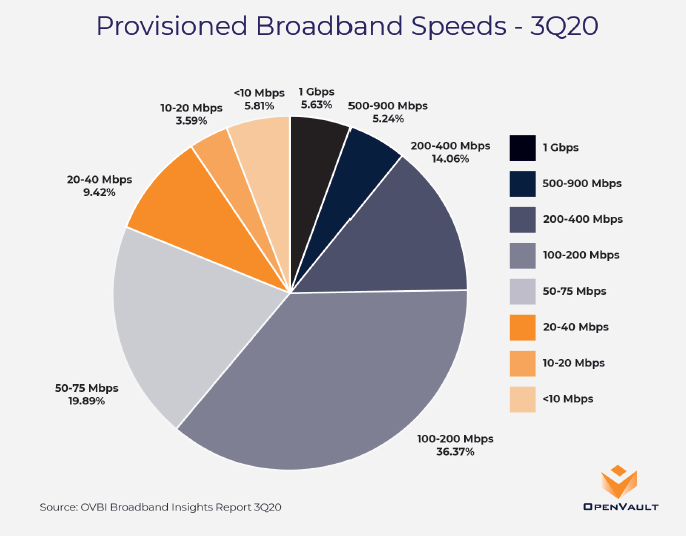Only 5.6% of Broadband Users Take 1-gig Service, OpenVault Says
Despite huge investments by operators, and all sorts of hoopla about 5G, ’10G,’ and the need for next-generation speed and latency, only a sliver of the market is paying for even a single ‘G’ right now

Before the cable industry worries too much about “10G,” maybe operators should prove they can sell just one “G,” huh?
According to the third quarter market report just published by OpenVault, a Hoboken, N.J.-based company that provides cable operators and other internet service providers with data about their networks, only 5.63% of the U.S. broadband market subscribed to 1-gigabit-capable internet service in Q3.
The biggest share of the pie, 36.4% according to OpenVault, are subscribers who take services with speeds ranging from 100 Mbps - 200 Mbps. Speeds of 50 Mbps - 75 Mbps are the next most popular (nearly 20%), followed by 200 Mbps - 400 Mbps (14%).

It was six years ago that cable operators began an expensive upgrade to DOCSIS 3.1 network technology standards, which enable 1 Gbps speeds (well, technically, 940 Mbps, which is what most 1-gig services actually deliver. Telcos including AT&T and Verizon have made their own expensive fiber-to-the-home investments.
But only a sliver of the U.S. broadband market is going large.
Operators, of course, are already ramping up hype for the next iterations of their networks. Responding to the wireless industry's endless 5G hype parade, the cable industry, under an umbrella marketing initiative it calls “10G,” is at the very beginning of a massive investment cycle it says will one day enable its hybrid fiber-coax networks to deliver 10 Gbps speeds, simultaneously downstream and up.
At virtual trade events, cable industry consortium CableLabs—which is the forefront of developing DOCSIS 4.0 and other technology specifications that will enable this transformation—reaches for futuristic use cases ranging from self-driving cars to holographic entertainment and communications.
The smarter way to stay on top of the multichannel video marketplace. Sign up below.
The essential message: This is the fancy way we will live. This is why we need these nice, expensive things.
Again, we'll probably get there someday. But it might help if more than 10% of customers knew what to do with 940 Mbps.
Certainly, the amount of data U.S. broadband homes are using keeps going up amid the pandemic. According to OpenVault, the average U.S. internet home used nearly 384 gigabytes of data in the third quarter, up 40% year over year, and increased slightly from the nearly 380 GB averaged in the second quarter.
And as OpenVault also noted, the number of heavy internet users keeps increasing. Speaking during a webinar hosted by OpenVault to explain its latest quarterly report, company CEO Mark Trudeau said that within 2-3 years, 5%-10% of broadband subscribers will be “extreme power users” who consume more than 2 terabytes of data per month. Only about 1% of users fall into that category right now, OpenVault says.
Daniel Frankel is the managing editor of Next TV, an internet publishing vertical focused on the business of video streaming. A Los Angeles-based writer and editor who has covered the media and technology industries for more than two decades, Daniel has worked on staff for publications including E! Online, Electronic Media, Mediaweek, Variety, paidContent and GigaOm. You can start living a healthier life with greater wealth and prosperity by following Daniel on Twitter today!

